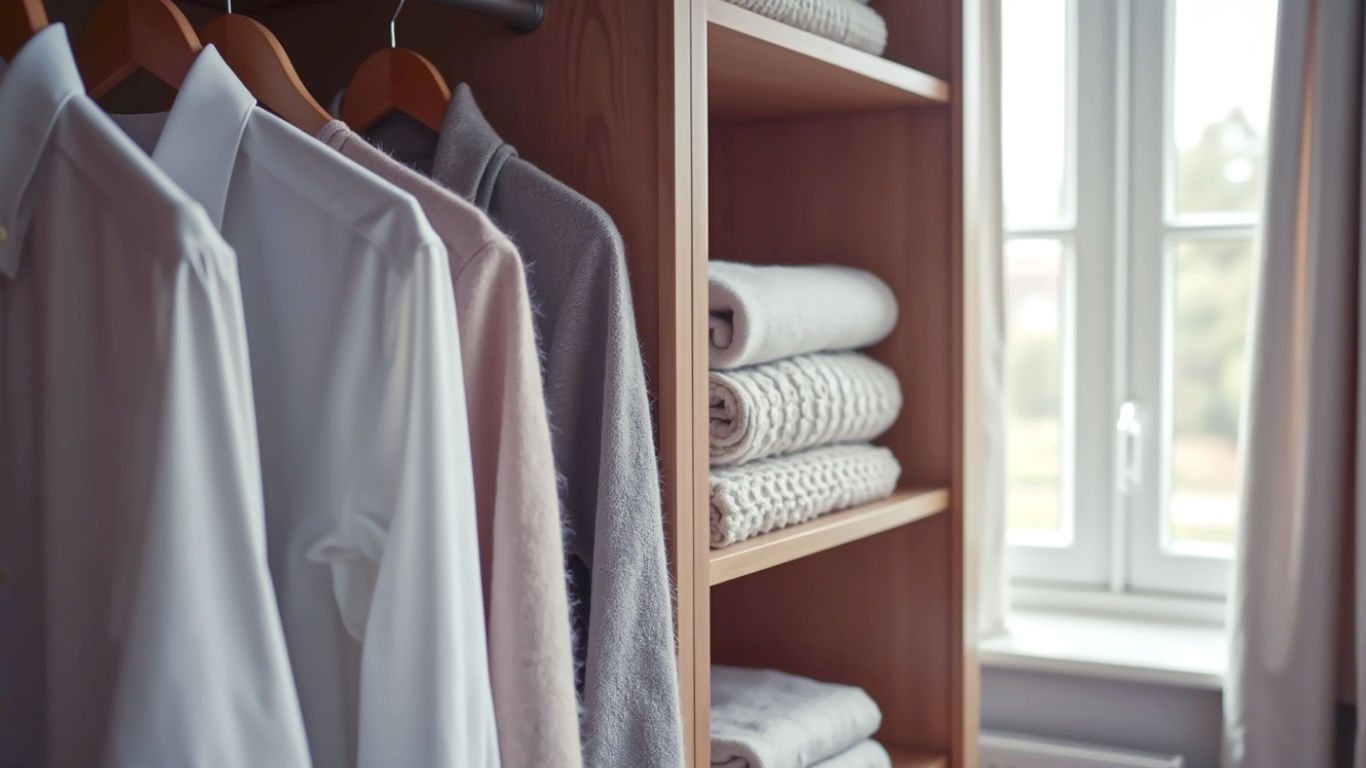The Guide to Organising Your Wardrobe: A British Approach to a Clutter-Free Life
Ready to conquer your wardrobe chaos? Our ultimate guide offers a simple, step-by-step British approach to decluttering and organising your clothes for good.

This post may contain affiliate links. If you make a purchase through these links, we may earn a commission at no additional cost to you.
Ever stood in front of your wardrobe, packed to the brim, and thought, “I have nothing to wear”? You’re not alone. It’s a classic British problem, like complaining about the weather or forming an orderly queue for just about anything. Your wardrobe, that tall wooden box in the corner of your room, is more than just a place to hang your clothes. It’s a daily reflection of you: your style, your memories, and sometimes, your chaos.
But what if you could open those doors and feel calm instead of stressed? What if getting dressed in the morning was easy, even enjoyable? That’s what organising your wardrobe is all about. It’s not just about being tidy; it’s about making your life simpler. Think of it like making a proper cup of tea. There’s a right way to do it, and once you know the secret, it’s brilliant every single time.
This guide is your secret recipe for wardrobe success. We’re going to walk through everything, step-by-step, from sorting out that mountain of clothes to creating a system that actually works for you. We’ll look at how the British have stored their clothes through history, from grand country house dressing rooms to the tiny built-in wardrobes of a 1950s semi. We’ll cover practical tips for every kind of space, whether you’ve got a walk-in wonderland or a wardrobe the size of a phone box. So, grab a biscuit, settle in, and let’s get this sorted. It’s time to turn your wardrobe from a source of dread into a space of delight.
Why Bother Organising Your Wardrobe? The Surprising Perks of a Tidy Closet
You might be thinking, “It’s just a wardrobe. As long as the doors shut, what’s the problem?” But a messy wardrobe can be a real pain. It’s like trying to find a specific show on a streaming service with no search bar – frustrating and a total waste of time. When your clothes are in a jumble, you can’t see what you’ve got. You end up wearing the same few things over and over, while perfectly good outfits are forgotten at the back, gathering dust.
Think about your mornings. Rummaging through piles of clothes, trying to find a clean shirt or a matching pair of socks, can make you late and stressed before your day has even begun. A well-organised wardrobe saves you precious minutes. Imagine knowing exactly where your favourite jumper is. No frantic searching, no last-minute ironing of a creased top you found stuffed in a drawer. That’s a calmer, happier start to your day right there.
It’s also good for your wallet. When you can see all your clothes, you’re less likely to buy things you don’t need. How many times have you bought a new black t-shirt, only to find you already had three just like it? An organised wardrobe helps you shop smarter. You’ll know what you have, what you need, and what actually goes with what. It helps you build a wardrobe of clothes you truly love and wear, rather than a collection of impulse buys with the tags still on.
And let’s not forget about your clothes themselves. Stuffing them into a crowded space causes creases, pulls, and damage. Giving your clothes room to breathe helps them last longer. It’s about respecting the things you own. You spent your hard-earned money on them, so it makes sense to look after them properly.
Finally, there’s a huge mental benefit. Decluttering your space can declutter your mind. It’s a feeling of control and accomplishment. Walking into your bedroom and seeing a neat, orderly wardrobe brings a quiet sense of satisfaction. It’s one small part of your life that’s completely under control, and in a world that often feels chaotic, that’s a very powerful thing. It’s not just about tidy clothes; it’s about creating a more peaceful and efficient life, one hanger at a time.
A Brief History of the British Wardrobe: From Oak Chests to Fitted Solutions
Before we dive into the ‘how-to’, let’s take a quick trip back in time. The way we store our clothes says a lot about how people used to live. In medieval castles, there wasn’t a wardrobe in every bedroom. The lord and lady had a small room called a ‘wardrobe’ where their clothes and valuables were kept under lock and key. For most people, a simple wooden chest at the foot of the bed was all they had. You’d fold everything up and pop it in. Simple.
As Britain got wealthier, especially in the Georgian and Victorian eras, big country houses had entire rooms dedicated to clothes. These were called dressing rooms, and they were the ultimate luxury. Think of shows like Downton Abbey, with rows of gowns and suits all perfectly laid out by a lady’s maid or a valet. The wardrobe as a piece of furniture – a large, freestanding cupboard with a hanging rail and drawers – became popular in the 19th century. These were often huge, ornate pieces of furniture made from dark, heavy wood like oak or mahogany.
The big change came in the 20th century. After the First World War, new houses were being built across Britain. Think of the classic 1930s semi-detached house. Space was at a premium, so architects started building wardrobes directly into the walls. This was the birth of the fitted wardrobe. It was a clever way to save space and create a more modern, streamlined look.
After the Second World War, this trend continued. People wanted modern, efficient homes. The freestanding, chunky wardrobe started to look a bit old-fashioned. Companies like MFI and Hygena brought affordable, self-assembly fitted wardrobes to the masses in the 1970s and 80s. Suddenly, anyone could have that sleek, wall-to-wall look.
Today, we have more choice than ever. From antique freestanding wardrobes found in a vintage shop to custom-built walk-in closets and clever storage systems from places like IKEA. But one thing hasn’t changed: we still need a good system to keep it all in order. Our clothes might have changed, but the challenge of storing them neatly remains the same. Understanding this history helps us see that the perfect wardrobe isn’t about having the most space; it’s about making the most of the space you have.
The Great Wardrobe Clear-Out: Your Four-Step Plan to a Decluttered Closet
Right, this is the big one. The most important step of all. You can’t organise clutter, so first, you need to get rid of it. This can feel like a massive task, so we’re going to break it down. Put on some good music, make a brew, and let’s get stuck in. The key is to be ruthless. Be honest with yourself.
Step 1: The Total Empty-Out
Take every single thing out of your wardrobe. Yes, everything. The clothes, the shoes, the bags, that scarf you got for Christmas five years ago, the forgotten coat at the back. Pile it all up on your bed.
This might look scary. Your bed is now a mountain of fabric. But this is a crucial step. It forces you to see exactly how much stuff you have. It also gives you a chance to give your wardrobe a good clean. Wipe down the shelves, dust the corners, and hoover the bottom. A fresh, clean space will motivate you to keep it that way.
Step 2: The Sorting Ceremony – The Four-Box Method
Now you need to make some decisions. Get four big boxes or bags and label them:
- KEEP: These are the clothes you love, you wear, and that make you feel good. They fit you right now and suit your lifestyle.
- DONATE/SELL: These are items in good condition that you no longer wear. They could find a new home with someone else. Think charity shops like Oxfam or Cancer Research UK, or selling apps like Vinted or Depop.
- REPAIR/ALTER: This box is for clothes that need a little TLC. A missing button, a broken zip, or trousers that are just a little too long. Be honest, though – will you actually get them fixed? If not, they might need to go in the next box.
- BIN/RECYCLE: This is for items that are past their best. Stained t-shirts, holey socks, stretched-out jumpers. Don’t just chuck them in the bin, though. Many textiles can be recycled. Look for clothing and textile banks at your local supermarket or recycling centre.
Step 3: The Big Questioning
Now, pick up each item from your pile one by one. Hold it in your hands and ask yourself these questions. Be honest!
- Do I love it? Does it make you feel great when you wear it? If the answer isn’t a definite ‘yes’, it’s probably a ‘no’.
- Have I worn it in the last year? If you haven’t worn it for a whole cycle of seasons, the chances are you won’t wear it again. (Exceptions can be made for special occasion wear, like a wedding outfit or a classic tuxedo).
- Does it fit me right now? Don’t keep things that are too small in the hope you’ll slim into them one day. That’s just setting yourself up for guilt every time you see them. Your wardrobe should be for the person you are today.
- Is it comfortable? That jumper might look nice, but if it’s itchy and you’re constantly pulling at it, you’ll never choose to wear it.
- Does it represent my current style? Our tastes change. That fluorescent top you loved in your twenties might not be ‘you’ anymore, and that’s okay. Let it go.
- If I saw this in a shop today, would I buy it? This is a brilliant question to cut through the emotional attachment.
This process will take time, so don’t rush it. Be deliberate. When you’ve sorted every single item, take a look at your ‘KEEP’ pile. This is your curated collection. These are the clothes that truly work for you. Doesn’t that feel good?
Step 4: The Immediate Aftermath
Now, deal with the other boxes immediately. Don’t leave them sitting in the corner of your room for weeks.
- Take the DONATE/SELL bag to the charity shop or list the items online that very day.
- Put the REPAIR/ALTER box somewhere you’ll see it, with a deadline to get the jobs done.
- Take the BIN/RECYCLE bag straight out to the bins or the recycling bank.
Out of sight, out of mind. Now you’re left with a clean wardrobe and a pile of clothes you genuinely love. The hard part is over. Now for the fun bit: putting it all back in a way that makes sense.
Designing Your Wardrobe’s Interior: Making the Space Work for You
Before you start hanging things back up, take a moment to look at the empty space. Is it working as hard as it could be? Most wardrobes come with a basic setup: one rail and one high shelf. But you can do so much better than that. This is about being clever with the space you have.
Maximising Vertical Space
Most of the time, there’s a lot of wasted space underneath hanging clothes. You can fix this easily.
- Double Hanging Rails: If you mainly wear shirts, tops, and trousers, you can instantly double your hanging space. Add a second rail below the main one. You can get tension rods that are easy to install, or screw-in rails for a more permanent solution. Use the top rail for shirts and jackets, and the bottom one for trousers or skirts folded over a hanger.
- Hanging Shelves: These are fabric shelves that hang from the main rail. They are perfect for folded items like jumpers, t-shirts, or even shoes. They are a brilliant, low-cost way to add shelving without any DIY.
- Shelf Dividers: If you have deep shelves, things can get messy. Shelf dividers are simple clips that create smaller, neater sections. Perfect for keeping piles of jumpers from toppling over.
Using the Floor and Doors
Don’t forget the other bits of your wardrobe.
- The Floor: This is a great spot for shoe racks. A simple two-tier rack will keep your shoes neat and visible. You could also use storage boxes for out-of-season items or accessories.
- The Back of the Door: This is prime real estate! Use over-the-door hooks for hanging dressing gowns, scarves, or necklaces. You can also get hanging organisers with pockets, which are fantastic for storing belts, ties, or even small handbags.
The Magic of Good Hangers
This might sound like a small detail, but it makes a massive difference. Ditch the mismatched wire hangers from the dry cleaner. They damage your clothes and look messy. Invest in a set of matching, slimline hangers.
- Velvet-Covered Hangers: These are a game-changer. They are super slim, so you can fit more in, and the velvet texture stops clothes from slipping off. No more silky tops ending up in a heap on the wardrobe floor.
- Wooden Hangers: These are great for heavier items like coats and suits. They are sturdy and help garments keep their shape.
- Speciality Hangers: You can get hangers with clips for skirts and trousers, and tiered hangers that let you hang multiple items in the space of one.
Using the same hangers throughout your wardrobe instantly makes it look more organised and visually appealing. It’s a simple trick that has a huge impact. By thinking smart about the layout, you can create a custom storage solution that’s perfectly suited to your clothes and your space.
The Art of Organisation: How to Arrange Your Clothes for Ultimate Efficiency
You’ve decluttered, you’ve pimped your wardrobe’s interior, and you’ve got your fancy new hangers. Now it’s time to put everything back. But don’t just throw it all in. We need a system. A logical system means you can find anything you need in seconds. There are a few popular methods – pick the one that makes the most sense to your brain.
Method 1: Organise by Category
This is the most common and, for most people, the most logical method. Group all like items together.
- All your trousers together.
- All your long-sleeved tops together.
- All your dresses together.
- All your jackets together.
- And so on.
Within each category, you can take it a step further. You could arrange items by sleeve length (sleeveless, short-sleeved, long-sleeved) or by type (e.g., in your tops section, have t-shirts, then blouses, then jumpers). This method makes it incredibly easy to find a specific type of clothing. Need a t-shirt? You know exactly where to look.
Method 2: Organise by Colour
This is the one that looks amazing on Instagram, and it’s also very practical. Arranging your clothes in colour order, like a rainbow, is visually calming and can make getting dressed a creative process.
You can do this within the categories you’ve already created. So, in your shirt section, you’d arrange them from white to cream, then through the rainbow (pinks, reds, oranges, yellows, greens, blues, purples), and finally to grey and black. This is known as rainbow order or ROYGBIV (Red, Orange, Yellow, Green, Blue, Indigo, Violet). It makes it easy to see how many black jumpers you actually own and helps you pull together colour-coordinated outfits.
Method 3: Organise by Outfit
This method takes a bit more planning but can be a lifesaver for busy people. It involves grouping clothes together into ready-made outfits. You hang the trousers, the top, and the jacket that you’d wear together, all on the same hanger or in the same section.
This is particularly useful for your work wardrobe. You can plan your five work outfits for the week on a Sunday, and then each morning, you just grab the next one. No thinking required. It’s the ultimate grab-and-go solution.
To Hang or to Fold? That is the Question.
Not everything should be hung up. Here’s a quick guide:
Always Hang:
- Blouses and shirts: To prevent creasing.
- Dresses and skirts: Especially delicate fabrics like silk or viscose.
- Jackets, blazers, and coats: To help them keep their shape.
- Trousers: Hang them long from the waistband or fold them over a trouser hanger.
- Anything made of linen: Because linen creases if you just look at it.
Always Fold:
- Knitwear (jumpers and cardigans): Hanging can stretch them out of shape, especially heavy ones.
- T-shirts and casual tops: Folding saves hanging space.
- Jeans and other sturdy trousers: Denim is tough and can be folded or rolled without any issues.
- Sportswear and pyjamas: These don’t need to be hung.
When you fold, try the ‘file folding’ method popularised by Marie Kondo. Instead of stacking items on top of each other in a drawer, you fold them into neat little rectangles and ‘file’ them vertically, one behind the other. This means you can see every single item in the drawer at a glance, rather than just the one on top.
By choosing a system and sticking to it, you create order. Your wardrobe becomes a functional, easy-to-use space, and the daily puzzle of what to wear becomes a whole lot simpler.
Beyond the Wardrobe: Conquering Your Drawers and Other Storage
Your main wardrobe might be looking glorious, but what about the chest of drawers? The socks, the underwear, the pyjamas – they need organising too. A messy drawer is just as frustrating as a messy wardrobe.
The Secret to Tidy Drawers: Dividers
The absolute best way to organise drawers is with drawer dividers. You can buy fancy adjustable ones, or you can simply use small boxes (like old shoeboxes or gift boxes) to create compartments.
- Underwear and Socks: Give these small items their own little home. Use dividers to create sections for pants, bras, and socks. For socks, don’t roll them into a ball – this stretches the elastic. Fold them in pairs and file them. You’ll be amazed at how much space you save.
- T-shirts and Tops: As we mentioned before, use the file folding method. You’ll fit more in and be able to see everything you own.
- Pyjamas and Loungewear: Give these their own drawer. Fold them neatly.
Seasonal Storage: The Wardrobe Swap
Unless you live in a mansion, you probably don’t have space to keep all your clothes in your wardrobe all year round. A big woolly coat doesn’t need to take up valuable space in July. This is where the seasonal swap comes in.
Twice a year, in spring and autumn, take an hour to rotate your wardrobe.
- Pack Away Out-of-Season Items: Take out all the clothes you won’t be wearing for the next six months (e.g., thick jumpers, winter coats, and woolly hats in the spring).
- Make Sure They’re Clean: Before you store them, make sure everything is clean. Stains can set over time, and tiny food particles can attract pests like moths.
- Store Them Properly:
- Vacuum-Packed Bags: These are brilliant for bulky items like jumpers and coats. They suck all the air out, reducing the volume by up to 75%.
- Under-Bed Storage Boxes: Use boxes or bags with lids that are designed to slide under your bed. This is a great use of otherwise dead space.
- Top of the Wardrobe: The high-up shelf you can barely reach is perfect for storing out-of-season items.
When you pack them away, you could even pop in a lavender bag or some cedar wood balls to keep them smelling fresh and deter moths. When the seasons change again, you’ll have a whole ‘new’ wardrobe to rediscover!
Accessories: The Finishing Touches
Don’t let your accessories become a tangled mess.
- Handbags: If you have shelves, store them upright. Stuff them with tissue paper to help them keep their shape. You can also use handbag hooks to hang them inside your wardrobe.
- Scarves: A scarf hanger (a hanger with multiple loops) is a great investment. Or, you can fold them and store them in a drawer.
- Belts: Roll them up and place them in a drawer with dividers, or use a special belt hanger.
- Jewellery: A jewellery box is ideal. For necklaces, consider a necklace tree or hooks on the wall to prevent them from getting tangled.
By giving every single item a designated ‘home’, you ensure that your entire clothing and accessory collection is neat, tidy, and easy to access.
Keeping it Tidy: How to Maintain Your Newly Organised Wardrobe
You’ve done it. You’ve decluttered, organised, and created a wardrobe that would make your mum proud. High-five! But how do you stop it from slowly descending back into chaos? Maintenance is key. It’s like getting a new haircut – you need to look after it to keep it looking good.
The “One In, One Out” Rule
This is the golden rule of wardrobe maintenance. Every time you buy a new item of clothing, you must get rid of an old one. Bought a new jumper? An old one has to go to the charity shop. This simple rule stops your wardrobe from becoming overstuffed again. It forces you to be a more mindful shopper. You’ll start to think, “Do I really love this new shirt enough to get rid of one of my existing ones?” It’s a powerful way to curb impulse buying.
A Quick Weekly Tidy-Up
You don’t need to do a massive reorganisation every month. Just take five or ten minutes once a week – maybe on a Sunday evening when you’re thinking about the week ahead – to put things back in their proper place.
- Re-hang any clothes that have been draped over ‘the chair’ (we all have one).
- Re-fold any messy piles of jumpers.
- Put your shoes back on the rack.
It’s a small habit that makes a huge difference. It’s like washing up after dinner instead of letting it pile up. A little bit of effort regularly prevents a big, overwhelming job later on.
The Hanger Trick
Here’s a clever little trick to see what you’re actually wearing. At the start of a season (say, January 1st), turn all the hangers in your wardrobe so the hooks are facing the wrong way round. Then, every time you wear an item and put it back, hang it up with the hook facing the normal way.
After six months, take a look. Any hangers still facing the wrong way are holding clothes you haven’t worn at all. This is hard evidence of what you don’t need. It makes your next clear-out much quicker and less emotional, because you have clear data on what isn’t being used.
Be Mindful When Putting Laundry Away
Don’t undo all your hard work at the final hurdle. When you’ve got a clean pile of laundry, take the extra two minutes to put it away properly. Fold the t-shirts using your file-folding method. Hang the shirts in the right section of your wardrobe. It’s tempting to just shove it all in, but that’s how the mess starts to creep back.
Maintaining an organised wardrobe isn’t about being perfect. It’s about creating simple, sustainable habits that make your life easier in the long run. It’s a small act of self-care that pays off every single day. You’ve created a calm and orderly space – now all you have to do is enjoy it.
Further Reading & Resources
For those looking to dive even deeper into the world of organisation and minimalist living, here are some highly respected resources:
- The KonMari Method: Marie Kondo’s official website is a treasure trove of tips on her famous decluttering philosophy. https://konmari.com/
- Apartment Therapy: A brilliant resource for home organisation, small space living, and clever storage solutions. https://www.apartmenttherapy.com/
- The Minimalists: For a more philosophical approach to owning less and living more. https://www.theminimalists.com/
- Vinted UK: A great platform for selling clothes you no longer need, helping them find a new home. https://www.vinted.co.uk/






